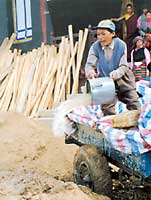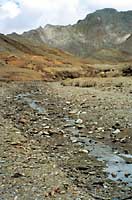|
|
||||
|
Under
examination the 3 springs which could provide an irrigation system to
Gangchen |
||||
|
The transportation of The ‘river’ at Sengrung |
Water:
nominated in «Gangchen Village Project» as the priority for the year
2000 - it also became one of our main priorities during this visit to
Tibet. In fact, during our second day in Gangchen we visited the three
sources of water located closest to the village. First
we travelled to the west of Gangchen, and as the village disappeared
behind spectacular rolling mountains we approached the village of Ten
situated approximately 10 km away. Here, on foot, we followed the path
of the small stream which actually originates from two natural springs.
Unfortunately, according to the local inhabitants, one of these springs
is not a completely reliable source of water as it often freezes in
winter and dries up in summer. Channelling
water from the other spring - although offering water all year round -
presents the immense task of laying at least 10 km of pipeline in hard,
rocky terrain, not to mention negotiating the mountains which stand
directly in the path of the two villages. The
second source of water, situated at Senrung (east of Gangchen Village),
also originates from two natural springs. In the mild weather conditions
one of the springs was already virtually dry and the other spring is
actually located at a point lower than Gangchen. Transporting water from
here would therefore require the use of a pump, however the lack of
power supplies is an essential point that has to be taken into
consideration. The
third, and nearest source of water, is situated at Bangkor just 2500
metres away from Gangchen. According to a recent local government report
this is in fact the most feasible of the three sites. After surveying
the number of people living in the monastery and village, the local
government has already proposed the idea to bring a pipeline directly
from Bangkor to a point on the hill behind Gangchen Monastery. They
have further suggested the installation of two water tanks: one on the
hill directly behind the monastery and the other in the village itself.
These two tanks would then serve seven standpipes, four located in the
monastery and three in the village. The local government have already
donated 2500 metres of metal pipeline to the monastery, although no
money can be provided by them to cover the major expenses of the work,
or to buy and install water tanks, standpipes, taps and so on. The
water project proposed in the «Gangchen Village Project» stresses
however the importance of a supply of water for livestock and irrigation
- which could really bring life and fertility to this land completely
transforming the lives of the people. Until
a professional topographic survey and detailed assessment have been
carried out (proposed in the project for this summer, by Jack Stern y
Cia. Ltda, a company specialised in design, engineering and construction
of water transportation and irrigation) it is difficult to actually
understand in reality which of the three fonts of water has the capacity
and potential to meet not one, but all the needs not only of Gangchen
Village, but also of those villages in the surrounding area. Habituated from birth to the commodity of limitless water, for us this completely new experience of having to search for water, and the all too evident reality that many people are forced to lead lives without access to any clean water brought new and more profound understanding and values to us - this element, so sparkling clear and limpid in its unpolluted form is indeed an exceptionally precious gift from nature. Sharon Dawson |
|||
|
|
||||



